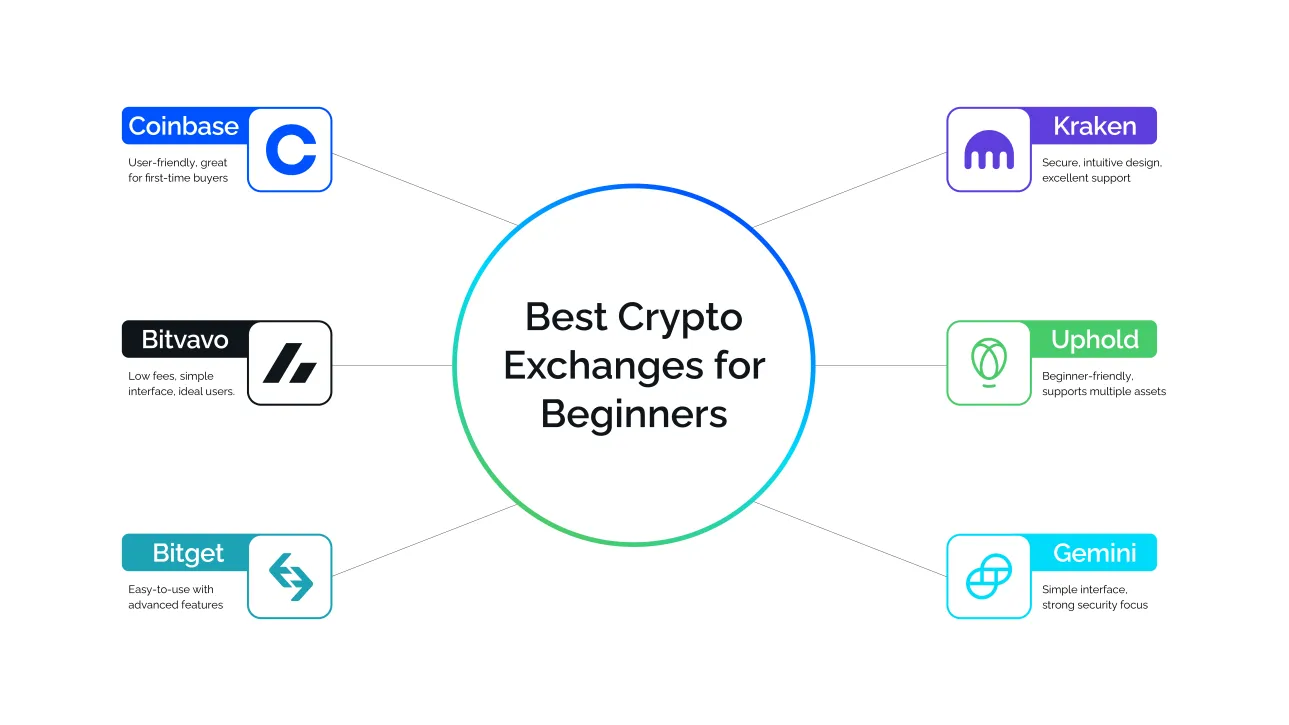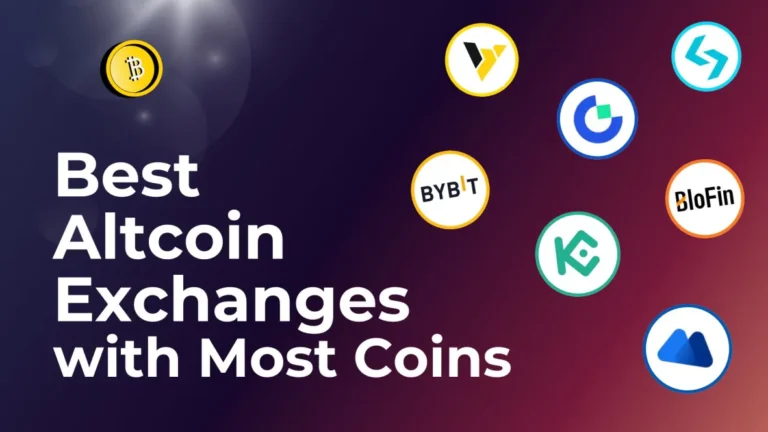Top 5 Crypto Exchanges For Beginners Reviewed
Crypto trading can quickly become incredibly confusing when choosing the wrong platform. Some crypto exchanges are carefully designed for seasoned professionals with loads of tools and advanced features, making it hard to navigate for beginners.
For this reason, finding the best crypto exchange for a beginner is the best option, as it allows users to gain all the necessary grooming and environment to hone their skills.
This guide aims to offer insight into crypto exchanges for beginners. It will outline their functions, the important factors to consider when selecting the right platform, and how beginners can purchase their first crypto.
1. Coinbase
2. Bitvavo
3. Bitget
4. Kraken
5. Uphold
6. Gemini
What is a Crypto Exchange for Beginners?
A crypto exchange for beginners is a platform designed specifically for buying, selling, and trading cryptocurrencies, making it essential for anyone new to the crypto space. These crypto exchanges are usually focused on spot trading, rather than futures trading. Futures trading platforms are generally much more advanced, not beginner-friendly and very risky due to high leverage options.
Beginner crypto exchanges are often tailored to ease the entry process, featuring user-friendly interfaces and straightforward features. These beginner-focused exchanges often provide a simple dashboard, simple charts without analysis tools, and educational resources, allowing newbies to learn about digital assets while they work on their trading skills.
Beginner crypto exchanges prioritize simplicity, not just with their interface, but also with their trading platforms. That means these exchanges provide very basic trading options, charts, and oftentimes a smaller amount of crypto assets to trade.
Additionally, these platforms offer demo trading for beginners to learn without having to put in actual funds. This helps protect them from the volatile nature of the crypto market.
Examples of crypto exchanges that offer services to beginners include Coinbase, Bitvavo, or Kraken.
How to Choose a Crypto Exchange for Beginners
Choosing the right crypto exchange is crucial for beginners. While users can just join any popular exchange, exchanges that have beginners in mind have some common features that cannot be overlooked. Here are some key factors to consider when choosing a crypto exchange for beginners:
User Interface (UI)
A beginner-friendly exchange should have a clean and organized user interface that makes navigation straightforward.
Look for platforms with visually appealing designs, clear labels, and easy access to essential functions such as trading, account management, and market information. A well-designed UI reduces confusion and helps users find what they need quickly.
User-Friendliness
User-friendliness goes beyond the appearance of an exchange. It includes the overall experience of using the platform. This means offering intuitive workflows, easy account setup processes, and accessible educational resources.
A user-friendly exchange often provides guided tutorials, FAQs, and customer support to assist beginners in understanding how to trade effectively.
Simple Features
When selecting a crypto exchange, prioritize those that offer simple features tailored for beginners. These may include basic trading options like market orders and limit orders without overwhelming complexity.
Avoid platforms that present advanced tools, such as margin trading or derivatives, unless you are ready to delve into those areas. A straightforward feature set allows beginners to focus on learning the fundamentals of cryptocurrency trading without getting lost in unnecessary complexities.
For beginners, starting with simple features provides a solid foundation before exploring more advanced trading strategies.
Transparent Fees
Understanding the fee structure is vital when choosing an exchange. Compare trading fees, withdrawal fees, and any hidden costs across different platforms.
Some exchanges may charge higher fees for certain transactions, which can significantly impact profitability, especially for smaller trades. Opt for exchanges that provide clear information about their fees upfront to avoid surprises.
- The industry standard is charging a maker and taker fee
- Maker fees refer to limit orders
- Taker fees refer to market orders
- Low spot trading fees are 0.1%
- Some exchanges charge a fixed fee for buying and selling
- Many crypto exchanges offer lower fees based on trading volume
Security
Security is absolutely crucial in cryptocurrency trading. Choose exchanges that implement security measures such as two-factor authentication (2FA), cold storage for funds, and encryption protocols.
A platform with a strong security history and transparent policies regarding data protection can give you peace of mind while trading.
Deposit and Withdrawal Methods
Crypto deposits are usually free of charge on the receiving side (the withdrawal side has to pay network fees!). Withdrawal fees are different for each cryptocurrency, depending on the network. This can range from $1 per transaction (USDT-TRC20) up to $5 or more per transaction (ETH-ERC20).
Additionally, we recommend you select an exchange that offers a variety of fiat deposit and withdrawal methods to suit your preferences, and most importantly your local currency.
Common options include bank transfers, credit/debit cards, and cryptocurrency deposits. Ensure the platform supports your local currency and has efficient processing times for both deposits and withdrawals.
- European crypto traders may want to look for crypto exchanges supporting SEPA transfers.
- US crypto traders should look for platforms offering ACH deposits.
Customer Support
Reliable customer support is essential for beginners who may encounter challenges while trading. Look for exchanges that provide 24/7 support through multiple channels such as live chat, email, or phone.
Responsive customer service can help resolve issues quickly and enhance your overall trading experience.
How to buy cryptocurrency as a beginner
Buying cryptocurrency can be tricky for first-timers, and will require that you have seen or read the process over and again. Therefore, it’s crucial to pay attention to each step detailed in this section using Coinbase’s platform, designed specifically for beginners.
Here’s the step-by-step instructions for purchasing crypto on Coinbase:
Step 1: Create a Coinbase Account
To begin, you need to create an account on Coinbase. Start by downloading the Coinbase app from your device’s app store or visiting their website. Click on “Get Started” and fill in your email address, then choose a strong password.
After signing up, you’ll need to verify your identity. This typically involves uploading a government-issued ID, such as a driver’s license or passport, and possibly providing proof of address, like a utility bill.
This verification process is crucial for security and compliance with regulations and may take anywhere from a few minutes to a couple of hours.
Step 2: Add a Payment Method
Once your account is verified, you’ll need to link a payment method. Coinbase offers several options, including debit card payments and wire transfers. There are also third-party payment options available on the platform.
Each method has its pros and cons; for example, linking a bank account generally incurs lower fees but may take longer for transactions to process (1-3 business days). In contrast, using a debit card allows for instant purchases but may involve higher fees.
Follow the prompts to link your chosen payment method, ensuring that the name on the payment method matches the name on your Coinbase account for successful verification.
Step 3: Start a Trade
Now that your account is set up and funded, you can begin trading. On the Coinbase app, tap the “Buy” button prominently displayed on the home screen. If you’re using the website, look for the “Buy & Sell” option in the upper right corner.
Step 4: Select the Cryptocurrency
Choose which cryptocurrency you want to buy from the list provided or use the search bar for quick access.
For beginners, starting with popular options like Bitcoin (BTC) or Ethereum (ETH) is often recommended due to its established presence in the market.
Take some time to read about each cryptocurrency if you’re unsure; understanding what you’re buying can help you make informed decisions.
Step 5: Enter the Purchase Amount
Input how much you want to spend in your local currency or specify how much cryptocurrency you wish to buy. The app will automatically calculate and display how much crypto you will receive based on current market prices.
Step 6: Preview Your Purchase
Before finalizing your purchase, review all transaction details carefully. Tap “Preview Buy” to see a summary of your transaction, which includes the amount of cryptocurrency you will receive and any applicable fees.
This summary will also show the total cost of your purchase in your local currency. It’s crucial to check this information thoroughly; mistakes at this stage can lead to unexpected costs or errors in your purchase.
Step 7: Complete Your Purchase
If everything looks correct, it’s time to finalize your transaction. Click “Buy Now” to complete your purchase. You’ll receive a confirmation screen indicating that your transaction was successful.
Depending on your payment method, it may take some time for the transaction to reflect in your account balance; bank transfers usually take longer than debit card purchases.
Step 8 (Optional): Add Recurring Purchases
If you plan to buy cryptocurrencies regularly, you can also set up recurring purchases. Coinbase allows users to automate their purchases by selecting how often they want to buy crypto.
That means you can select a daily, weekly, or monthly repurchase plan on the platform. This feature can help you build your investment gradually without having to remember to make purchases manually.
Bottom Line
Throughout this guide, we have emphasized the importance of thoroughly researching and understanding the exchanges you wish to join before signing up.
We explored key factors to consider when choosing an exchange, including user interface, user-friendliness, transparent fees, security measures, deposit and withdrawal methods, and customer support.
By following these guidelines, beginners can equip themselves with the knowledge necessary to make informed decisions in the dynamic world of cryptocurrency. With a solid understanding of how to choose an exchange and how to buy their first crypto, new investors can approach the market with greater confidence and clarity.
FAQS
What is the best crypto trading platform for beginners?
Beginners seeking to kickstart their journey can head to Coinbase. Coinbase offers a suite of products and services that make it ideal for any crypto newbie.
Which crypto is best for beginners to trade?
Beginners are advised to start their journey with trading pairs like Bitcoin and Ethereum. This helps them understand how the market moves, with BTC and ETH being less volatile compared to other tokens.
Do crypto exchanges for beginners charge fees for deposits?
Most beginner-friendly exchanges do not charge deposit fees. However, the payment method may attract some charges by default.
Where do I learn crypto as a beginner?
Beginner platforms provide users with an academy where they can become familiar with various concepts around the cryptocurrency landscape.








